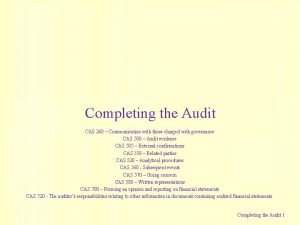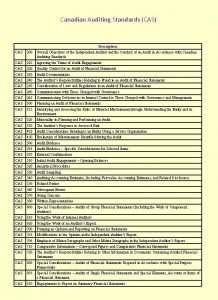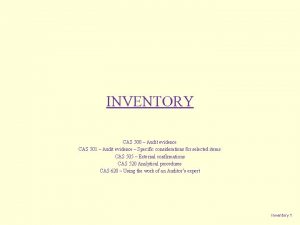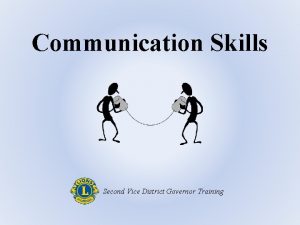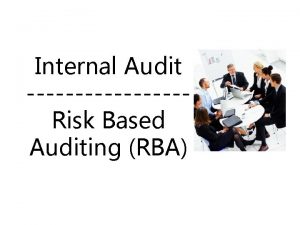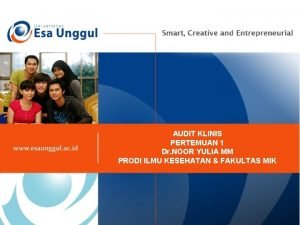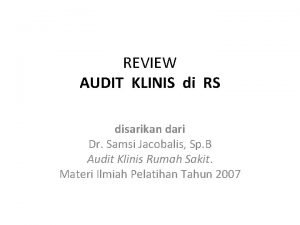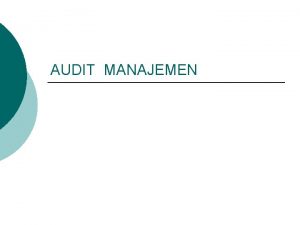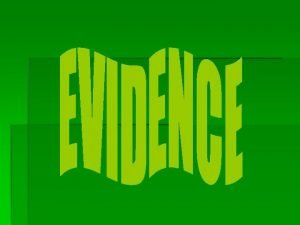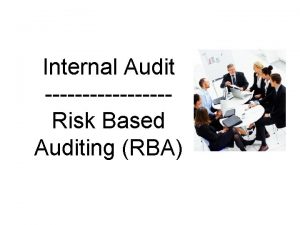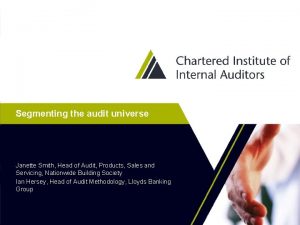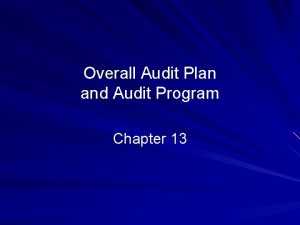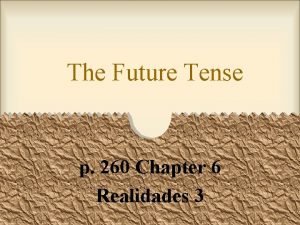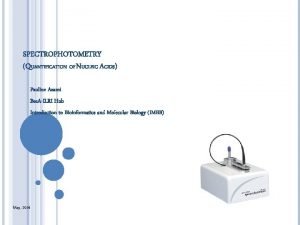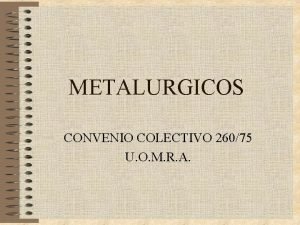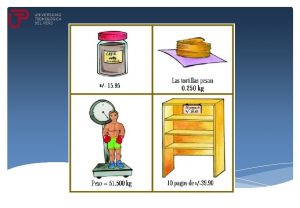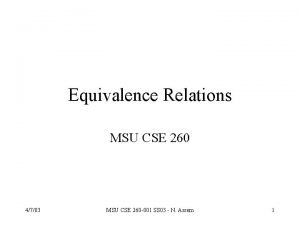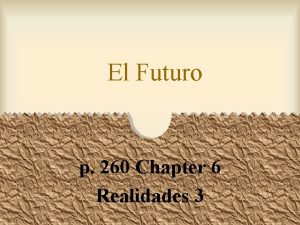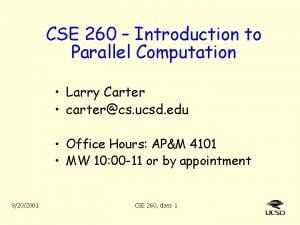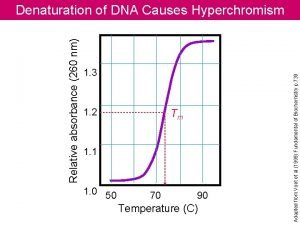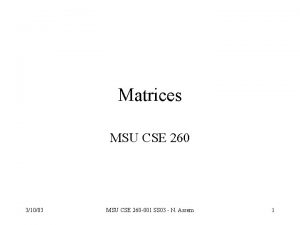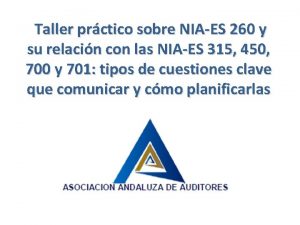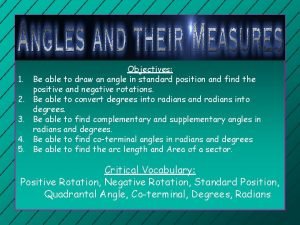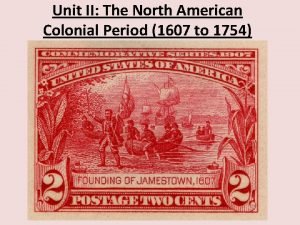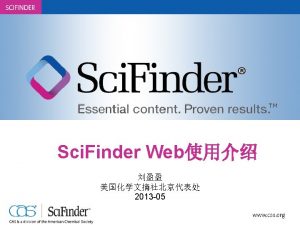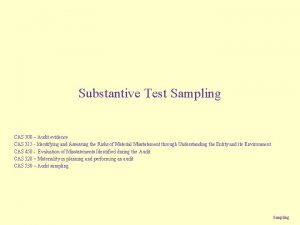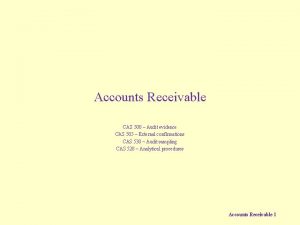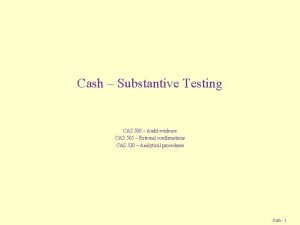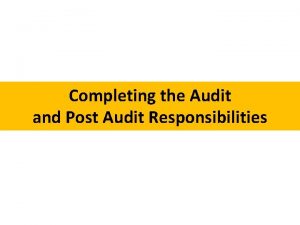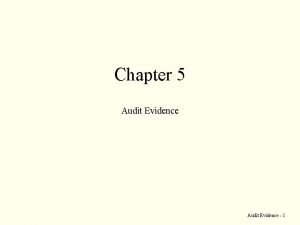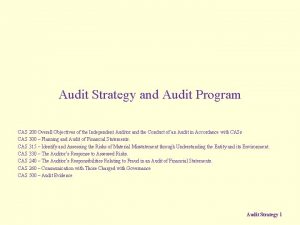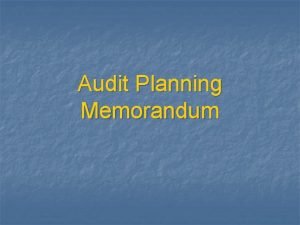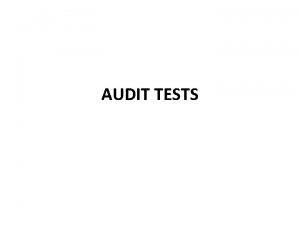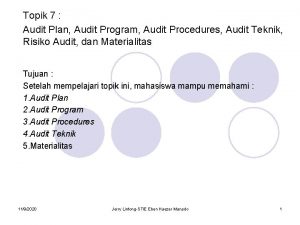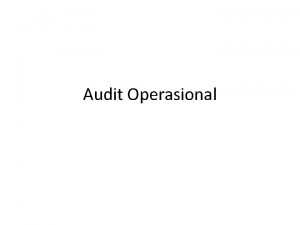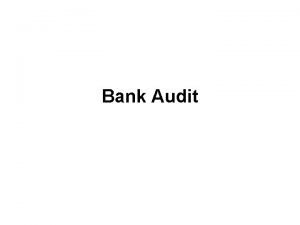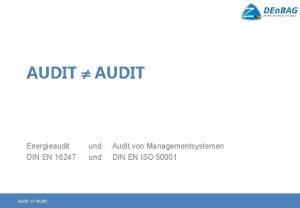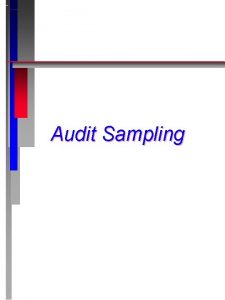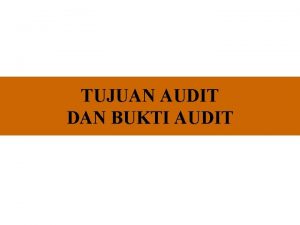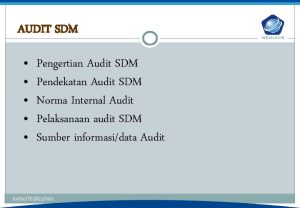Completing the Audit CAS 260 Communication with those




































- Slides: 36

Completing the Audit CAS 260 – Communication with those charged with governance CAS 500 – Audit evidence CAS 505 – External confirmations CAS 550 – Related parties CAS 520 – Analytical procedures CAS 560 - Subsequent events CAS 570 – Going concern CAS 580 – Written representations CAS 700 – Forming an opinion and reporting on financial statements CAS 720 - The auditor’s responsibilities relating to other information in documents containing audited financial statements Completing the Audit 1

Introduction This chapter covers completion of the financial statement audit. • Some procedures are particular to year end • • • Working paper review Related party transactions Overall analytical procedures Unusual transactions Legal letters and contingencies Subsequent events Dual dating of the audit report Management representation letter Presentation and disclosure Completing the Audit 2

The Sequence of Audit Events Interim audit work period (before year end): • • • Auditor evaluates internal control. Auditor may begin work on testing controls. Auditor can apply substantive procedures as at an interim date. Year-end work: • • • Complete the work on testing controls. Complete work on audit of balances. May take months after the actual year-end date to complete this work. Completing the Audit 3

Completing the Audit of Revenue and Expenses • Revenue accounts represent • Expense accounts represent A number of the revenue and related topics were audited in whole or in part with other related account groups. Completing the Audit 4

Revenue Accounts Audited in Other Processes Revenue and Related Topics Related Account Group Sales and sales returns Receivables Lease revenues Capital assets and receivables Franchise revenue Receivables, intangibles Dividends and interest Receivables, investments Gain/loss on asset disposals Fixed assets, investments Rental revenue Receivables and investments Royalty and license revenue Receivables and investments Long-term sales commitments Revenue and receivables Product line reporting Revenue and receivables Accounting policy disclosure Revenues and receivables Completing the Audit 5

Expense Accounts Audited in Other Processes Expense Related Account Group Purchases, cost of goods Inventories Inventory valuation losses Inventories Warranty and guarantee expense Inventories and liabilities Royalty and license expense Inventories Marketing and product R&D Investments and intangibles Investment value losses Investments and intangibles Rental property expenses Investments and intangibles Amortization of intangibles Investments and intangibles Bad debt expense Receivables Completing the Audit 6

Minor Expenses Some minor expense accounts like office supplies or utilities will not be covered until the end of the audit. Completing the Audit 7

Audit Documentation Working Paper Review Working papers prepared by the audit staff will be reviewed by the audit supervisor in detail. • This is done to • The audit manager and audit partner will focus their review on the overall scope of the audit. • A second partner review is conducted Completing the Audit 8

Audit of Related Party Transactions Auditors have a responsibility to obtain reasonable assurance that related parties have been identified, and disclosed in the financial statements. • Related parties exist when How to gather evidence Completing the Audit 9

Overall Analytical Procedures CAS 520 - The auditor shall design and preform analytical procedures near the end of the audit that assist the auditor when forming an overall conclusion … Remember that analytical procedures can be used at all points of the audit. • Techniques include: • Explanations for fluctuations Completing the Audit 10

Unusual Transactions Audit evidence and reporting problems can arise when there are unusual transaction, particularly near the end of the audit Transactions can be run through Collecting a number of sales, particularly in the field of technology, also give rise to reporting concerns. Completing the Audit 11

Contingencies What is a contingency? Only recognized on the balance sheet if If cannot be estimated If not likely Contingent assets are not recognized until Completing the Audit 12

Financial Statement Treatment of Contingencies Unlikely to occur No disclosure Not determinable Footnote Likely to occur and the amount can be estimated Financial statements are adjusted Likely to occur and the amount cannot be estimated Footnote Completing the Audit 13

Letters to Detect Contingencies The procedures of obtaining a lawyer’s letter and a letter of representation from management are deferred to the last day of field work. These representations are dated Auditors are responsible for determining Other procedures: Completing the Audit 14

Communication with Auditee’s Lawyer Auditors are required to make certain inquiries designed to elicit specific information. Made in accordance with the Joint Policy Statement of January 1978 approved by The Canadian Bar Association and the Auditing Standards Committee of the Canadian Institute of Chartered Accountants. In a letter, the client requests the attorney to provide the auditor with information regarding In addition, there other audit procedures, as previously mentioned, that would be designed to determine materially contingent liabilities. Completing the Audit 15

Legal Confirmation Letter Example ABC Company Ltd. 123 Main Street Toronto, Ontario 31 January, 201 Y Such & Such Barristers and Solicitors 765 John Street Toronto, Ontario To Whom It May Concern: In connection with the preparation and audit of our financial statements for the fiscal period ended 31 December 201 X we have made the following evaluations of claims and possible claims with respect to which your firm's advice or representation has been sought: Description (Name of entity, name of other party, nature, amount claimed and current status) Evaluation (Indicate likelihood of loss (or gain) and estimated amount of ultimate loss (or gain), if any; or indicate that likelihood is not determinable or the amount is not reasonably estimable. ) Would you please advise us, as of (effective date of response), on the following points: a. Are the claims and possible claims properly described? b. Do you consider that our evaluations are reasonable? c. Are you aware of any claims not listed above which are outstanding? If so, please include in your response letter the names of the parties and the amount claimed. This enquiry is made in accordance with the Joint Policy Statement of January 1978 approved by The Canadian Bar Association and the Auditing Standards Committee of the Canadian Institute of Chartered Accountants. Please address your reply, marked "Privileged and Confidential", to this company and send a signed copy of the reply directly to our auditor, GHW & Co. Llp, 321 Yonge Street, Toronto, Ontario Yours truly, John James, President c. c. GHW & Co Completing the Audit-16

Analyzing Legal Expense • Why analyze legal expenses? • • • May give indication of contingent liabilities. Identifies law firms where confirmation may be required. Identifies events that may need to be confirmed with law firms. Completing the Audit 17

Commitments What is a commitment? Commitments are certain with respect to the result Contingencies are uncertain Where are they are usually disclosed? The procedures Completing the Audit 18

Subsequent Events (CAS 560) Events occurring subsequent to the balance sheet date Certain material events that occur after the balance sheet date, but before the end of the field work require either an adjustment or disclosure. Type I: Type II: Completing the Audit 19

Subsequent Events Time Period Required to obtain evidence for subsequent events Not required to obtain evidence * Field work completed Field work Audit report signed Balance sheet date Directors approve and sign financial statements Audited financial statements released to the public * But if auditor becomes aware of a fact that existed at the date of the audit report And if the auditor had known at that date that this fact could have caused them to modify the report, the auditor should: Completing the Audit 20

Type 1: Adjustment of Dollar Amounts Required Provides new information regarding a financial condition that exists at the balance sheet date. Adjustment is required Examples: A loss on uncollectible trade accounts receivable The settlement of litigation Completing the Audit 21

Type II: No Adjustment, but Disclosure Required Occurrences after the balance sheet date, but do not require adjustment of accounts at balance sheet date. Examples: Sale of a bond or capital stock issue. Purchase of a business. Settlement of litigation Loss of plant or inventories Completing the Audit 22

Audit Program for the Subsequent Period The auditor should perform other auditing procedures with respect to the period after the balance-sheet date for the purpose of ascertaining the occurrence of subsequent events that may require adjustment or disclosure essential to a fair presentation of the financial statements. Possible procedures: Completing the Audit 23

Dual-Dating in the Audit Report Applied when a major event comes to the auditor's attention between The financial statements may include the event as an adjustment or disclosure. The auditor dual dates the audit report (as of the end of workpaper review, except footnote XX, which is dated later). Completing the Audit 24

Management’s Representation Letter - CAS 580 A form letter on the client’s letterhead signed by senior company management. This may also lead the auditor to the discovery of contingencies. Generally, it provides weak evidence. However, in some cases management representations are the only evidence available. Completing the Audit 25

Typical contents of the letter a) b) c) d) e) f) g) h) i) j) Management is responsible for the proper presentation of the financial statements in accordance with the applicable accounting framework All financial records have been made available to the auditors All board of directors minutes are complete Management has made available all letters from regulatory agencies regarding financial reporting noncompliance There are no unrecorded transactions The net effect of all uncorrected misstatements is immaterial The management team acknowledges its responsibility for the system of financial controls All related party transactions have been disclosed All contingent liabilities have been disclosed All unasserted claims or assessments have been disclosed Completing the Audit 26

Final Evidence Accumulation The auditor has to gather some final evidence besides the examination of Contingencies Subsequent events 1. Analytical procedures 2. Evaluation and conclusions regarding going concern concept Completing the Audit 27

3. Management representation letter 4. The annual report and CAS 720 This relates to other information in the annual report of which the financial statement are part Auditor must review the information to see if there is any inconsistency between the financial statements and the other information If an error exists Completing the Audit 28

5. Management discussion and analysis (MD&A) Usually required in Canada by provincial Securities Commissions Comment from management in the annual report Completing the Audit 29

Sufficiency of Evidence • Who is responsible for this? • • • Senior audit staff and the audit partner are responsible They assess all the evidence in the context of engagement risks and the client risk profile. This is a detailed review • helps ensure that all field work has been completed and outstanding queries cleared. Completing the Audit 30

Unadjusted Misstatement Worksheet • Also called a Summary of Unadjusted Items What does this worksheet keep track of? • The primary us of this worksheet? • What happens if the auditor comes to the conclusion that there may be a material misstatement? • Completing the Audit 31

Auditor Communications • Communications with management and/or the audit committee • • with respect to several matters. The following are required: • • Illegal acts Reportable internal control conditions (internal control deficiencies that could lead to material errors) Completing the Audit 32

Management Letter The purpose of a management letter The focus Many auditor combine this with the letter on internal control Completing the Audit 33

Problem DC 15 -3, Page 844 The following events occurred in independent cases, but in each instance the event happened after the close of the fiscal year under the audit but before the financial statements were authorized for issue, which is also the report date. For each case, state what impact, if any, you would expect on the financial statements (and notes). The balance sheet date in each instance is December 31, 20 X 1. 1. On December 31, the commodities handled by the company had been traded in the open market for $1. 40 per kilogram. The price had prevailed for two weeks, following an official market report that predicted vastly enlarged supplies; however, no purchases were made at $1. 40. The price throughout the preceding year, and several prior years, had been about $2. On January 18, 20 X 2, the price returned to $2, following the disclosure of an error in the official calculations of the prior December – correction of which destroyed the expectations of excessive supplies. Inventory at December 31, 20 X 1, had been valued on a lower-of-cost-and-net-realizable-value basis, using the prevailing price known at that time, $1. 40. 2. On February 1, 20 X 2, the board of directors adopted a resolution accepting an investment banker’s offer to guarantee the marketing of $100 of preferred shares. 3. On January 22, 20 X 2, one of the auditee’s three major plants burned down, a $50 million loss that was covered to $40 million by insurance. 4. The auditee in this case is an open-end-type investment company. In January, 20 X 2, new management took control. By February 20 X 2 it had sold 90% of the investments carried at December 31, 20 X 1, and had purchased substantially more speculative ones. 5. This company has a wholly owned but not consolidated subsidiary producing oil in a foreign country. A serious rebellion began in that country on January 20 X 2, and continued beyond the completion of your audit work. There has been extensive coverage of the fighting here. Completing the Audit 34

6. The auditee, Comtois Corp. , sells property management software systems. Shortly before its December 31, 20 X 1, year-end, Comtois’s president finalized a large sale to a provincial ministry. The contract has ben completed and all the terms agreed to by the assistant deputy minister, but the minister herself is the only one authorized to sign the contract because of the large dollar amount involved. As of the date Comtois’s board authorized the financial statements to be issued March 3, 20 X 2, Comtois has not yet received the signed contract because the minister has not been available. The president wants to recognize the revenue in Comtois’s 20 X 1 fiscal year anyway so that the salespeople and managers involved can be paid a bonus this year based on it. The auditee’s stated accounting policy for revenue recognition on these types of sales, established five years earlier, is to recognize revenue when the contract is signed. 7. During its fiscal year ending December 31, 20 X 1, Noriker Inc. issued common shares to its vicepresident of marketing. At the date of issuing these shares, the company also provided the vice-president with a non-interest bearing loan of $50, 000 to purchase the shares. While reviewing the minutes of all the Noriker board of directors meetings during the audit fieldwork, Noriker’s auditor notes that in a meeting on February 12, 20 X 2, the Noriker board agreed to forgive this loan, effective that day. ( © 2000, American Institute of CPAs. ) Completing the Audit 35

Problem DC 15 -5, Page 846 The controller of Kim Engineering LTD. (KEL), sent a legal representation letter to KEL’s law firm at the request of the company’s auditors. The controller told the auditors that there are no ongoing lawsuits. The lawyers replied to the letter, agreeing that there were no outstanding or possible claims of which they have knowledge, or for which their legal advice has been sought. However, the controller was not aware that the board of directors had sought legal advice from a second law firm regarding a harassment lawsuit. Due to the nature of the matter, the board of directors did not want anyone to know about the possible claim. There are no records of it outside of the president’s office, but the auditor noticed it when reviewing the minutes of the board of directors meetings. The auditor, therefore, requested that a letter be sent to the second law firm as well. One of the members of the board of directors is Yung, who started the company 20 years ago, but is now retired from any duties other than being a director. When the company first started, Yung performed almost all of the duties herself, but over the years, her duties have been assigned to other people. For example, only the controller or the president of the company sign cheques on behalf of the company, and the controller’s authority is limited to $15, 000. Any cheque request must be supported by an authorized purchase requisition, and any request over $15, 000 must be authorized by the president. The accounting manager does all of the bank requisitions himself, but his assistant enters the journal entries according to the accounting manager’s instructions. Required: a) Indicate what effect will be on the audit if the auditor receives no response from the second law firm. b) If the second law firm replies and provides information to the auditor, indicate how the auditor should treat this information for financial statement purposes. c) State whether the control risk is high or low, and support your decision with four points. (Adapted from External Auditing (AU 1), September 2010, with permission of Chartered Professional Accountants of Canada, Toronto, Canada. ) Completing the Audit 36
 Cea.cas700.com
Cea.cas700.com Canadian auditing standards
Canadian auditing standards Cas audit meaning
Cas audit meaning Communication with those charged with governance
Communication with those charged with governance Communication works for those who work at it
Communication works for those who work at it Perbedaan audit konvensional dengan audit berbasis risiko
Perbedaan audit konvensional dengan audit berbasis risiko Audit klinis adalah
Audit klinis adalah Beda audit medis dan audit klinis
Beda audit medis dan audit klinis Penyelesaian audit dan tanggung jawab pasca audit
Penyelesaian audit dan tanggung jawab pasca audit Konsep dasar audit
Konsep dasar audit Prosedur audit bottom-up dan audit top-down
Prosedur audit bottom-up dan audit top-down Difference between interim audit and final audit
Difference between interim audit and final audit Perbedaan audit konvensional dengan audit berbasis risiko
Perbedaan audit konvensional dengan audit berbasis risiko Audit
Audit What is audit universe
What is audit universe Overall audit plan and audit program
Overall audit plan and audit program Tener future tense
Tener future tense 260/280 ratio
260/280 ratio Cct 260/75
Cct 260/75 Dos cajas de galletas contienen en total 260 galletas
Dos cajas de galletas contienen en total 260 galletas Equivalence relation
Equivalence relation Realidades 3 capitulo 6 el futuro (p. 260)
Realidades 3 capitulo 6 el futuro (p. 260) Ed 260
Ed 260 Ucsd cse260
Ucsd cse260 Amy gottfried umich
Amy gottfried umich Ucas tariff points meaning
Ucas tariff points meaning 260 nm absorbance
260 nm absorbance Cse 260 msu
Cse 260 msu Reishauer rz 260
Reishauer rz 260 Si9a
Si9a Act 5 summary hamlet
Act 5 summary hamlet 380 en yakın yüzlüğe yuvarlama
380 en yakın yüzlüğe yuvarlama Hamlet act 5 scene 1 line 260
Hamlet act 5 scene 1 line 260 Zone of inhibition
Zone of inhibition 260 degrees in standard position
260 degrees in standard position 300000/260
300000/260 Msu cse 260
Msu cse 260
